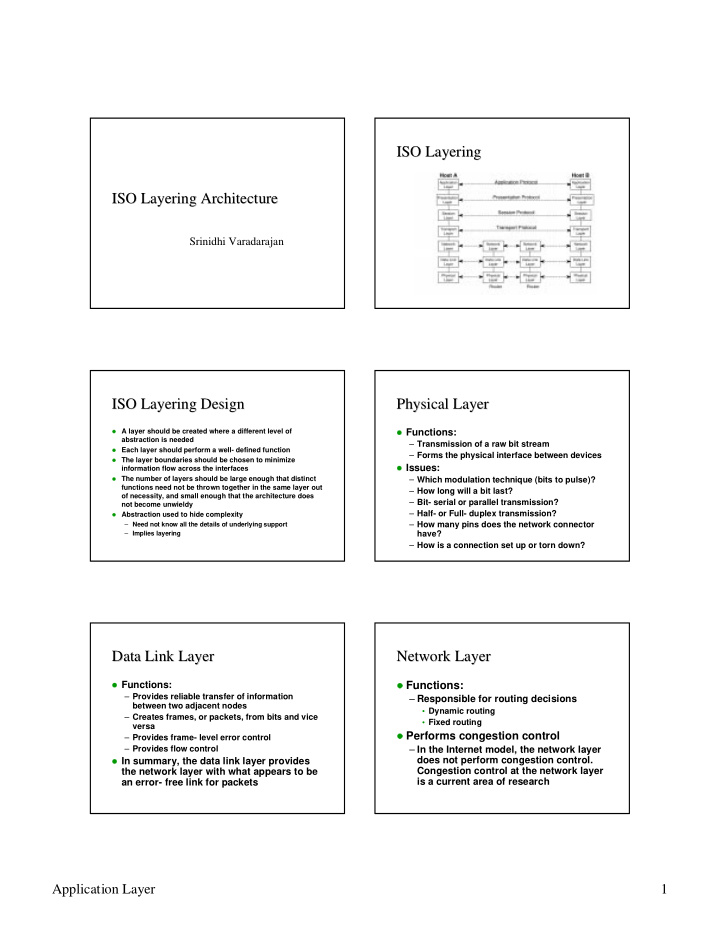



ISO Layering ISO Layering ISO Layering Architecture ISO Layering Architecture Srinidhi Varadarajan ISO Layering Design ISO Layering Design Physical Layer Physical Layer z Functions: z A layer should be created where a different level of abstraction is needed – Transmission of a raw bit stream z Each layer should perform a well- defined function – Forms the physical interface between devices z The layer boundaries should be chosen to minimize z Issues: information flow across the interfaces z The number of layers should be large enough that distinct – Which modulation technique (bits to pulse)? functions need not be thrown together in the same layer out – How long will a bit last? of necessity, and small enough that the architecture does – Bit- serial or parallel transmission? not become unwieldy – Half- or Full- duplex transmission? z Abstraction used to hide complexity – How many pins does the network connector – Need not know all the details of underlying support have? – Implies layering – How is a connection set up or torn down? Data Link Layer Network Layer Data Link Layer Network Layer z Functions: z Functions: – Provides reliable transfer of information – Responsible for routing decisions between two adjacent nodes • Dynamic routing – Creates frames, or packets, from bits and vice • Fixed routing versa z Performs congestion control – Provides frame- level error control – Provides flow control – In the Internet model, the network layer does not perform congestion control. z In summary, the data link layer provides Congestion control at the network layer the network layer with what appears to be is a current area of research an error- free link for packets Application Layer 1
Transport Layer Session Layer Transport Layer Session Layer z Functions: z Functions: – Hide the details of the network from the – May perform synchronization between session layer several communicating applications – Example: If we want replace a point- to- point link with a satellite link, this change should not – Groups several user- level connections affect the behavior of the upper layers into a single “session” – Provides reliable end- to- end communication – Perform end- to- end flow control – Perform packet retransmission when packets are lost by the network z In the Internet model, the transport layer also offers congestion control. Presentation Layer Presentation Layer Application Layer Application Layer z Application layer protocols are z Functions: application- dependent – Performs specific functions that are z Implements communication between requested regularly by applications two applications of the same type – Examples: z Examples: • Encryption • ASCII to Unicode, Unicode to ASCII – FTP • LSB- first representations to MSB- first – HTTP representations – SMTP (email) ISO Layering: Problems ISO Layering: Problems TCP/IP Layering TCP/IP Layering z Seven layers not widely accepted z A simplified model z Standardized before implemented z Network Layer – Hosts drop packets into this layer, layer z Top three layers fuzzy routes towards destination- only z Internet or TCP/ IP layering promise- try my best widespread z The transport layer – Reliable/unreliable byte-oriented stream Application Layer 2
Internet Design Principles End- -to to- -End Argument End Argument Internet Design Principles End z Scale z Saltzer, Reed and Clark [1984] – Protocols should work in networks of all sizes z End- to- end arguments in system design and distances z Main idea z Incremental deployment – A function can only be completely and – New protocols need to be deployed gradually correctly implemented with the knowledge and z Heterogeneity help of the applications standing at the – Different technologies, autonomous communication end points organizations z Complexity at the edges as opposed to the z End- to- end argument core – Networking functions should be delegated to the edges; application knows best End- -to to- -End Argument: Advantages End Argument: Advantages End z Simple functions implemented in network z Complex functions in the core tend to optimize the network for a given applications. E.g. reliability, encryption z Hard to reengineer the network to some other application – telephony Vs data use Application Layer 3
Recommend
More recommend